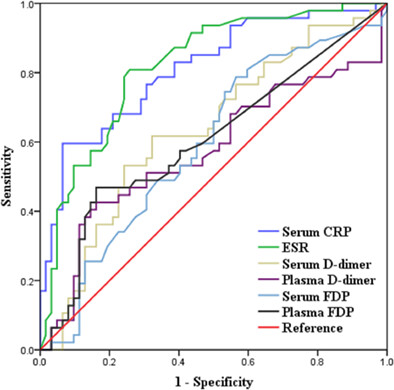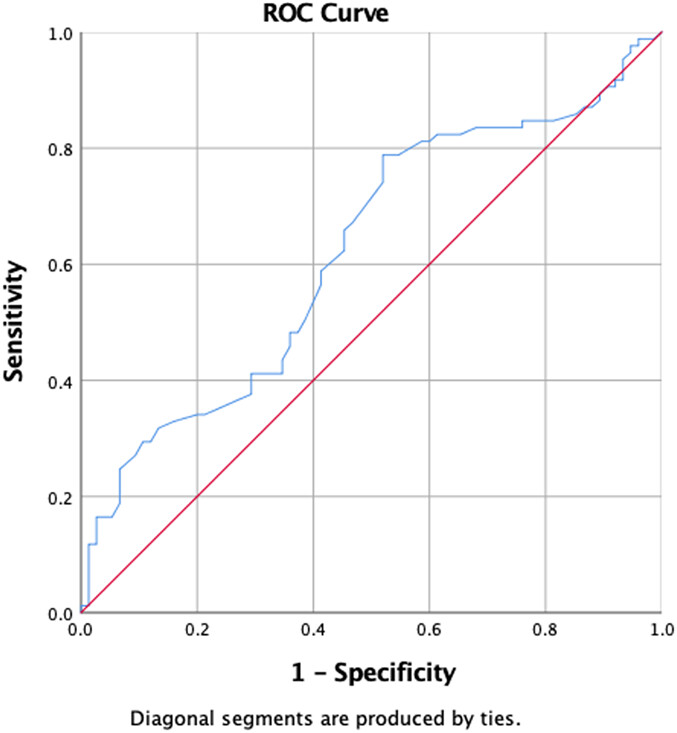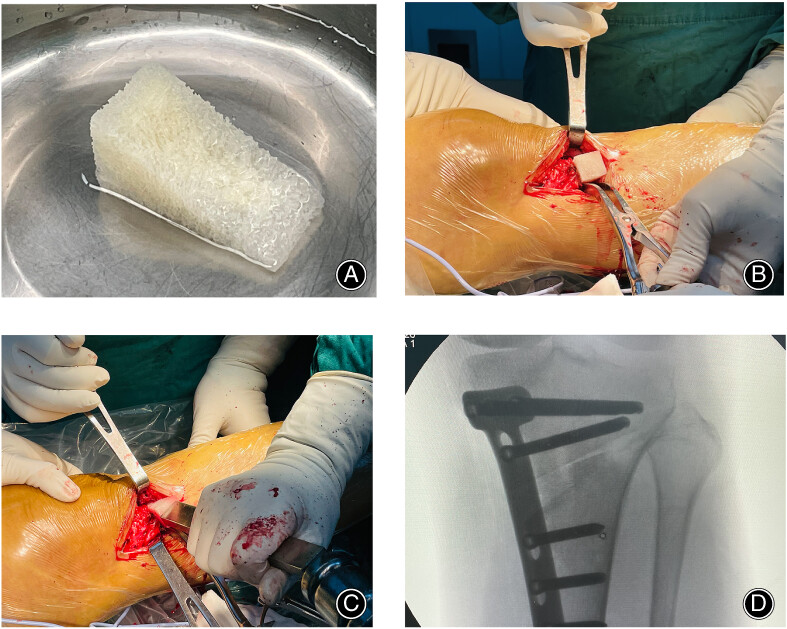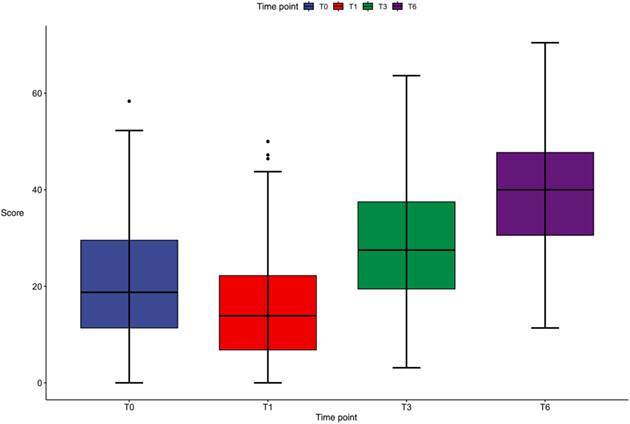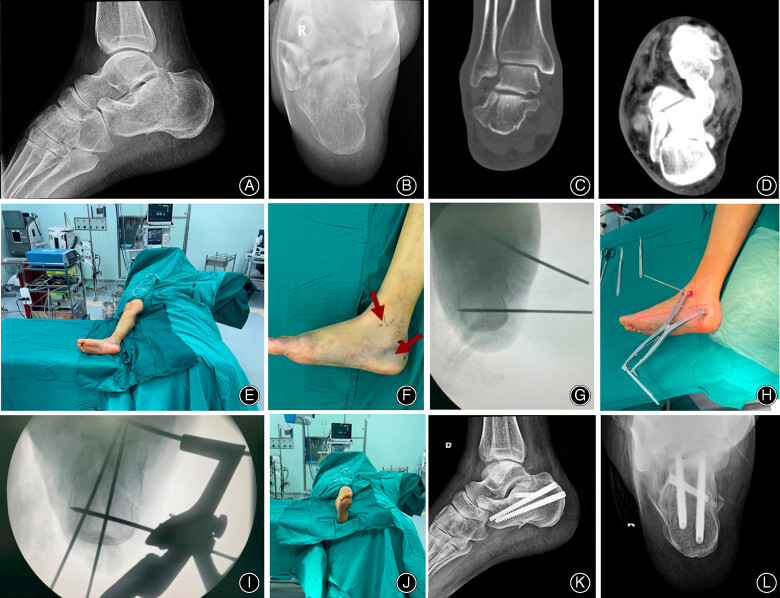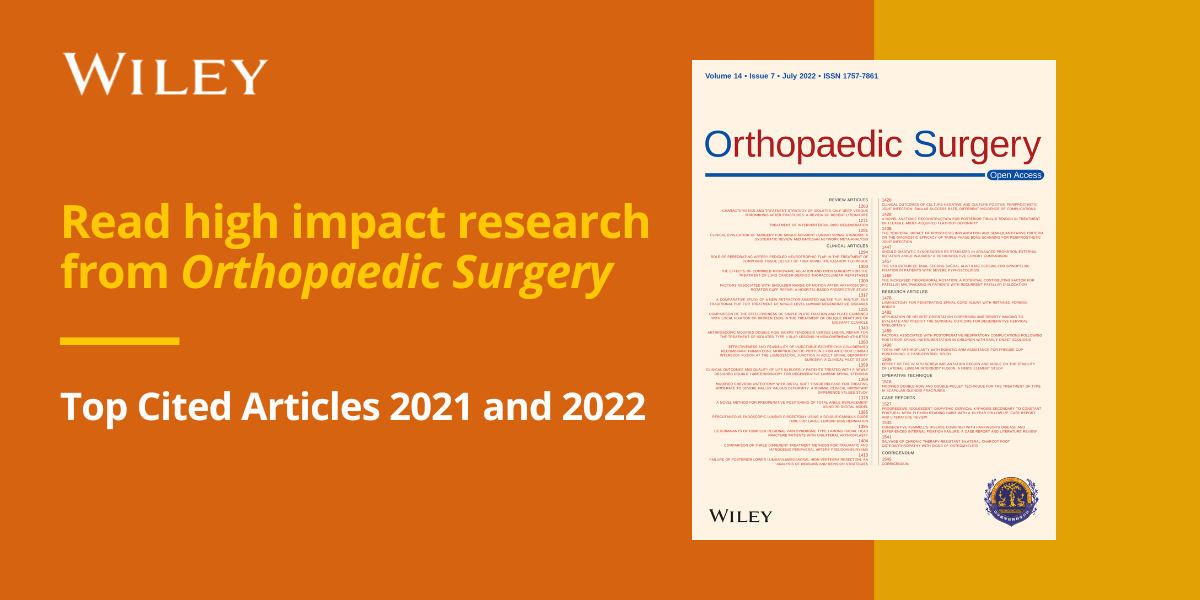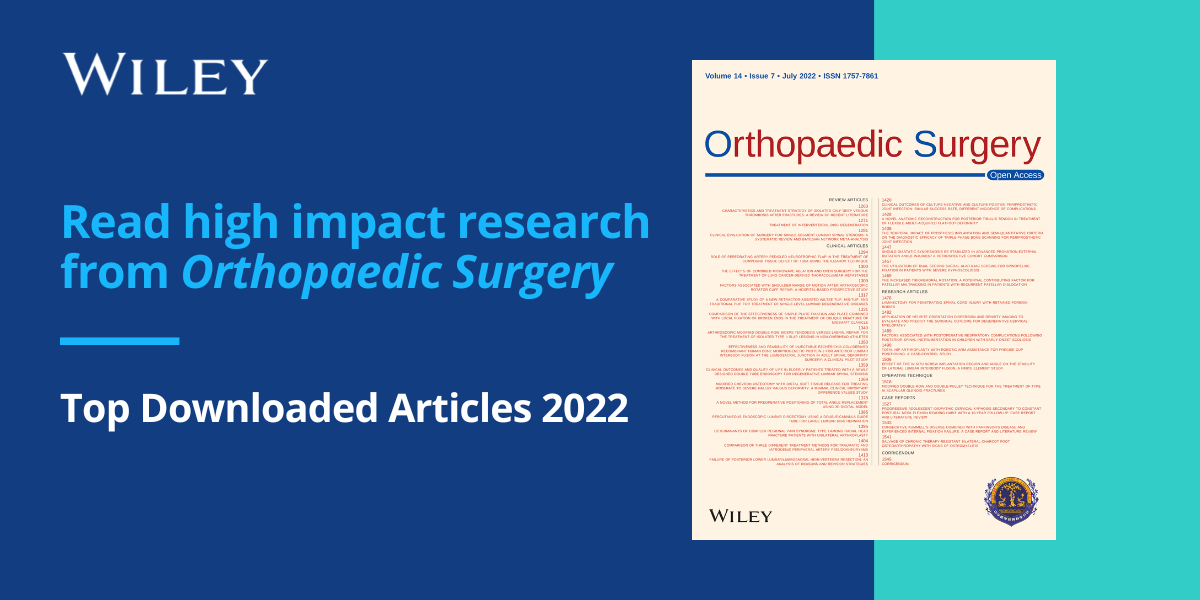Journal list menu
Export Citations
Download PDFs
ISSUE INFORMATION
REVIEW ARTICLE
Kinesitherapy for Knee Osteoarthritis Patients Physical and Psychological Health Based on “Traditional Chinese Exercise” Management Modalities: A Systematic Review and Meta-Analysis of Randomized Controlled Trials
- Pages: 3-16
- First Published: 29 November 2023
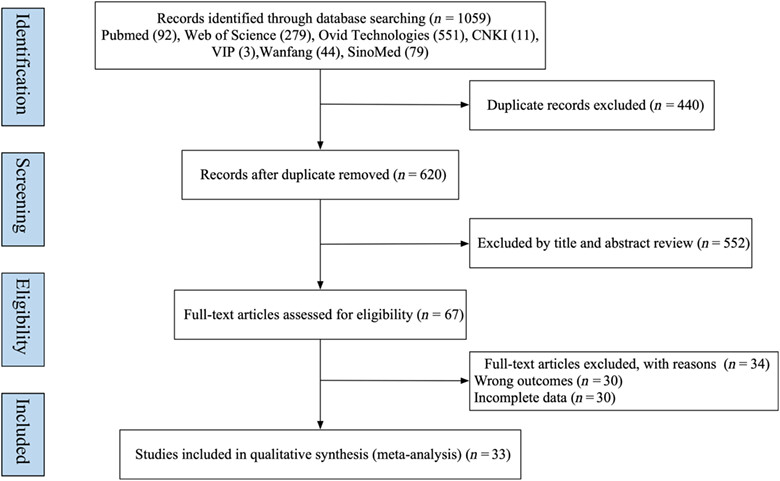
Traditional Chinese exercise (TCE) such as Tai Chi has a good effect on improving the physical function of patients with knee osteoarthritis, but less attention has been paid to the impact on the psychological health of patients, and there is currently a lack of sufficient evidence to support it. The aim of this systematic review and meta-analysis was to update, synthesize, and present the best available evidence on the patient physical and mental health based on TCE management modalities in KOA. TCE significantly improved physical function and mental health in patients with knee osteoarthritis. Additional high-quality evidence is required to confirm the effect of TCE therapy on physical and mental health in KOA patients.
CLINICAL ARTICLES
Comparison of Long-term Follow-Up of n-HA PA66 Cage and PEEK Cage of Lumbar Interbody Fusion in Multi-level Degenerative Lumbar Diseases: A Stepwise Propensity Score Matching Analysis
- Pages: 17-28
- First Published: 12 November 2023
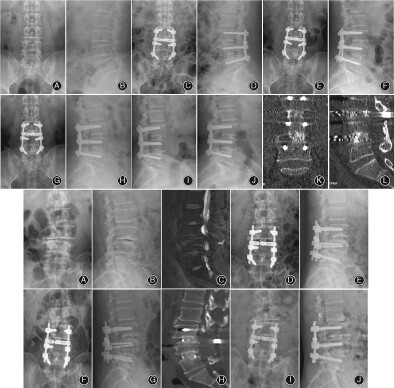
The findings of this study suggest that the outcomes of the n-HA/PA66 cage group are comparable to those of the polyether ether ketone (PEEK) cage group, with a similar high fusion rate and low cage subsidence rate as PEEK cages, except its lower rate of adjacent segment degeneration (ASD) occurrence.
Unreliability of Serum- or Plasma-based Assays of D-dimer or Fibrin (Fibrinogen) Degradation Product for Diagnosing Periprosthetic Joint Infection: A Prospective Parallel Study
- Pages: 29-37
- First Published: 17 November 2023
Admission Inflammation Markers Influence Long-term Mortality in Elderly Patients Undergoing Hip Fracture Surgery: A Retrospective Cohort Study
- Pages: 38-46
- First Published: 20 November 2023

Hip fractures in elderly patients are associated with a high mortality rate. Recent studies suggest that some inflammation biomarkers may be useful to estimate excess mortality. This study aimed to investigate the prognostic value of admission inflammation biomarkers in elderly patients with hip fracture. This was a retrospective study of 1085 elderly hip fracture patients. The inflammation biomarkers included monocyte to lymphocyte ratio (MLR), neutrophil to lymphocyte ratio (NLR), and C-reactive protein (CRP) to albumin ratio (CAR). The predictive performance of NLR, MLR and CAR was assessed by ROC curve analysis and the association between admission inflammation markers and mortality was evaluated by Cox proportional regression. The 30-day, 1-year, 2-year, and 4-year mortality were 1.6%, 11.5%, 21.4% and 48.9%. After adjusting the covariates, preoperative CAR ≥ 1.36 was associated with 1 year mortality, preoperative NLR ≥ 7.28 and CAR ≥ 1.36 were found to be associated with 4 year mortality. Age, CCI score, and low hemoglobin at admission were also risk factors for postoperative mortality. Admission NLR and CAR may be useful indicators for predicting the long-term mortality of elderly patients undergoing hip fracture surgery.
A Novel Multiple Screw Distraction Reducer System in the Treatment of Scoliosis with a Severe Rib Hump
- Pages: 47-56
- First Published: 27 November 2023
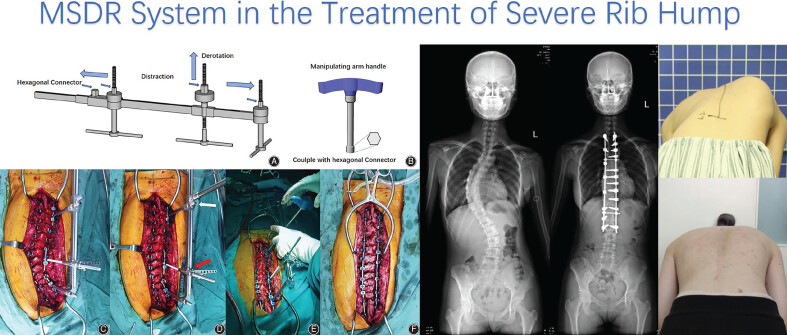
This study introduced the application of the multiple screw distraction reducer system for the treatment of scoliosis with a severe rib hump. The system, enabling better coronal alignment, thoracic kyphosis, and axial derotation, could be a safe and effective technique for severe rib hump correction in AIS.
The Quality of Life of the Patients with Thoracic Ossification of the Ligamentum Flavum after Surgery Using EQ-5D-5L
- Pages: 57-71
- First Published: 27 November 2023
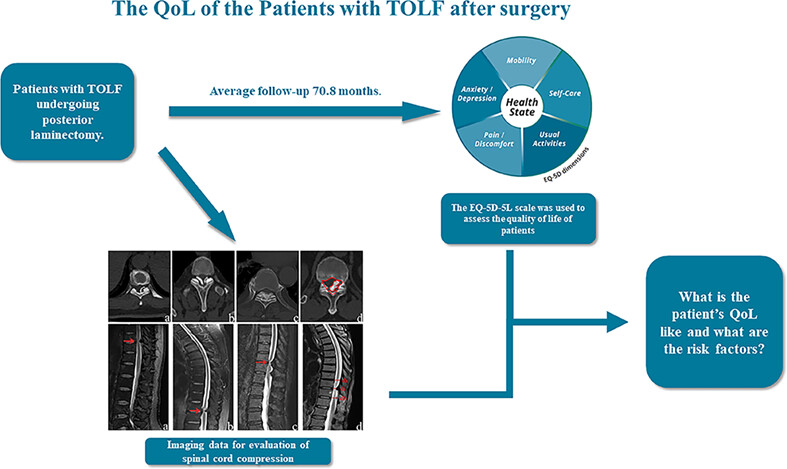
By using the EQ-5D-5L assessment shows that the long-term quality of life (QoL) of patients with thoracic ossification of the ligamentum flavum (TOLF) is generally satisfactory in the postoperative period, but problems with usual activities, pain/discomfort and mobility are more common above the moderate level than in other dimensions. The QoL is influenced by a number of factors, of these, preoperative modified Japanese Orthopaedic Association (mJOA) score, age, comorbid diabetes, major symptom presentation, BMI, and spinal canal occupancy rate (MRI) are significantly correlated with the corresponding dimensions. In the distant postoperative period, there is still a need to focus on patient mobility and pain/discomfort management to better manage patients after posterior laminectomy for TOLF.
Postoperative Prevalence and Risk Factors for Serum Hypokalemia in Patients with Primary Total Joint Arthroplasty
- Pages: 72-77
- First Published: 28 November 2023
Surgical Strategy for Recurrent Giant Cell Tumor in the Thoracolumbar Spine
- Pages: 78-85
- First Published: 28 November 2023
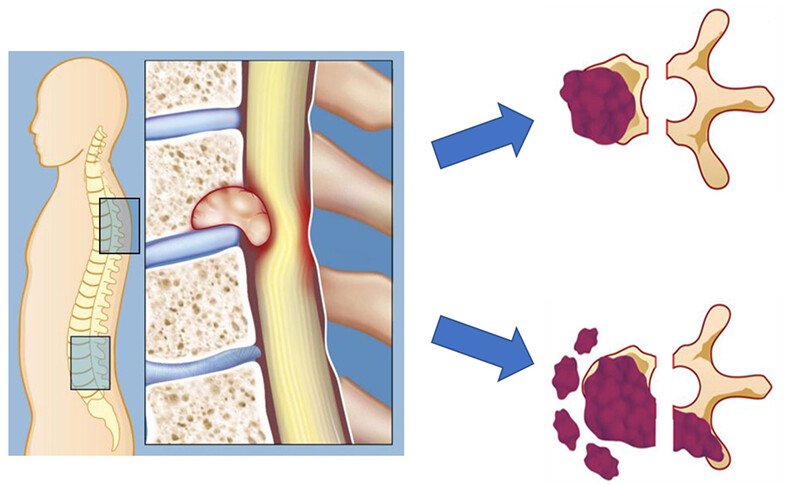
Compared to TPS, TES with wide/marginal margin should be offered to patients with RGCT whenever feasible given its long-term benefits in local control and symptom alleviation. Additionally, survival analysis was carried out which showed that lower Ki67 index and postoperative application of denosumab are indicators for better prognosis.
Bone Healing and Clinical Outcome Following Medial Opening-wedge High Tibial Osteotomy Using Wedge-Shaped Cancellous Allograft
- Pages: 86-93
- First Published: 28 November 2023
Predicting Union, Osteomyelitis, and Amputation Outcomes of Gustilo IIIC Open Tibial Fractures: A Retrospective Study
- Pages: 94-103
- First Published: 28 November 2023
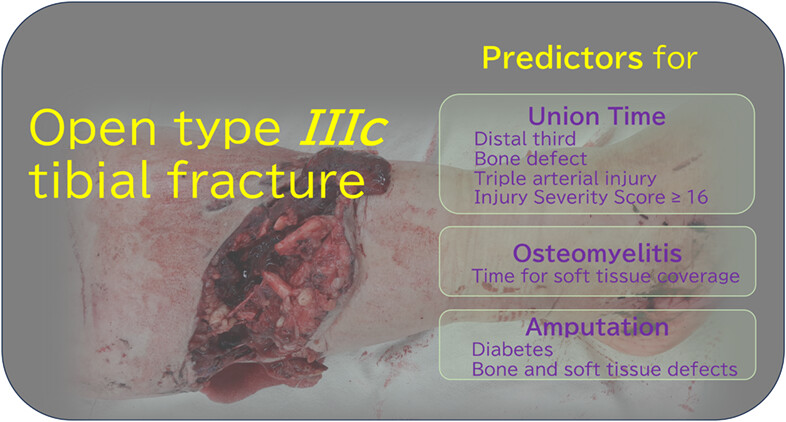
Open type IIIC tibial fractures involving the distal third of the tibia, fractures with bone defects, triple arterial injury, and multiple trauma with ISS ≥16 points demonstrated delayed union, and an effective prediction system for union time was introduced in this study. Early soft tissue coverage can reduce the risk of osteomyelitis. Finally, diabetes and severe bone and soft tissue defects pose a higher risk of amputation.
Possible Mechanism and Treatment Results of Combined Pediatric Fractures of the Humeral Lateral Condyle and Ipsilateral Ulnar Olecranon
- Pages: 104-110
- First Published: 29 November 2023
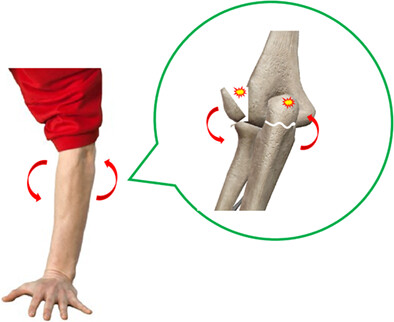
Hypothetical diagram of the mechanism of combined fractures of lateral condyle of the humerus and ipsilateral olecranon. This fracture occurs as the children fall on an outstretched and supinated elbow. An upward cubits varus stress is transmitted axially through the elbow joint to the lateral condyle. The olecranon is compressed and levered by the distal humerus during the process, resulting in fractures. Alternatively, the olecranon may be fractured as the forearm externally rotates against the distal humerus and pulls off the lateral condyle through tensed lateral collateral ligament complex. Contracted triceps muscle and arm extensors may also be important contributors.
Development and Validation of a Risk-Prediction Nomogram for Preoperative Blood Type and Antibody Testing in Spinal Fusion Surgery
- Pages: 111-122
- First Published: 03 December 2023
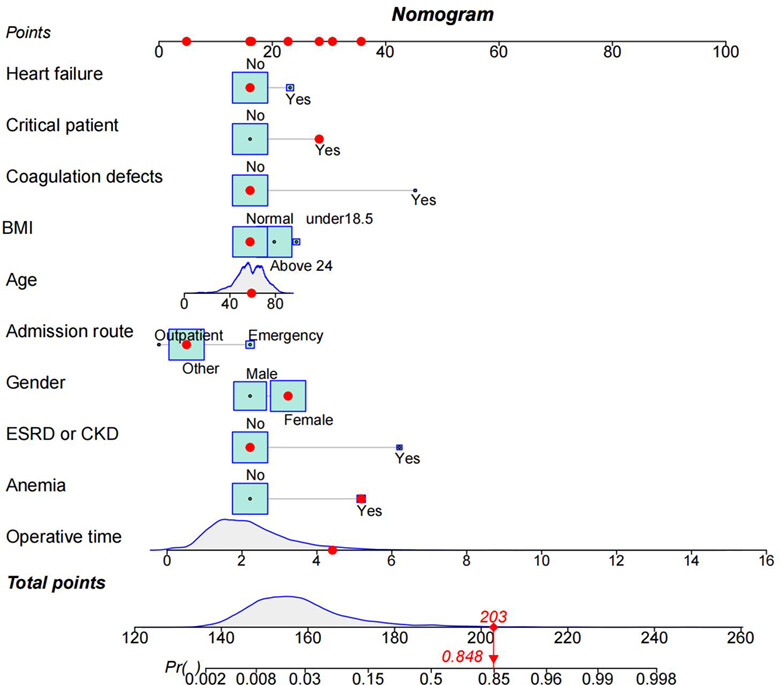
Our study is the first to combine preoperative baseline patient characteristics, diagnostic and surgical parameters into an innovative, easy-to-use risk prediction nomogram for preoperative assessment of transfusion risk in patients undergoing spinal fusion, so that preoperative T&S testing can be selectively scheduled in appropriate patients to reduce healthcare and patient costs.
Do Patients with Borderline Anemia Need Treatment before Total Hip Arthroplasty? A Propensity Score-Matched Cohort Study
- Pages: 123-131
- First Published: 04 December 2023

Anemia treatments for patients with borderline anemia before THA significantly reduced hidden blood loss and total blood loss in the perioperative period and decreased the drop of hemoglobin and hematocrit without increasing postoperative complications. Interestingly, the postoperative drop of hemoglobin, hematocrit, and albumin was significantly greater in the non-anemia patients than the borderline anemia patients.
Introduction and An Analysis of Inter- and Intra-observer Validity to the Classification of Hoffa-Like Tibial Plateau Fractures
- Pages: 132-139
- First Published: 04 December 2023
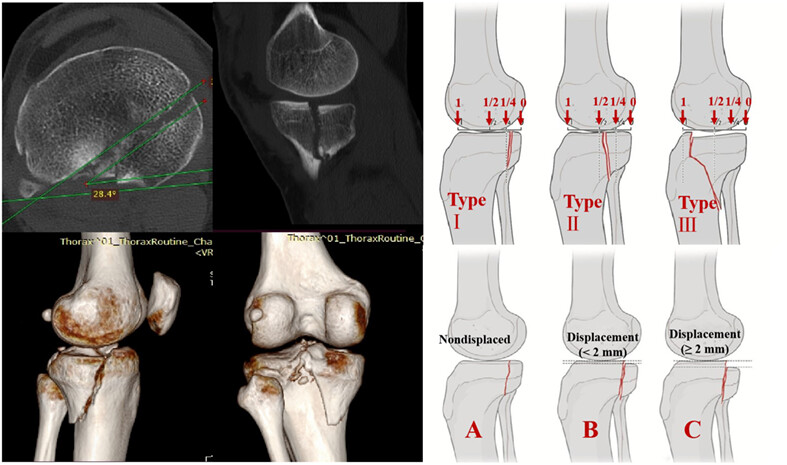
The posterior coronal shearing fracture of the tibial plateau is uncommon in clinic and is easily ignored by orthopedic surgeons. We define this particular fracture as a Hoffa-like fracture of the tibial plateau and proposed a new CT-based classification system. Based upon the clinical outcomes, specific treatment strategies for each type were recommended. Additionally, Kappa (κ) statistics showed that the new classification has a high agreement level of inter- and intra-observers.
Kirschner Wire Internal Fixation of the Medial Tibiotalar Joint for Indirect Repair of Deltoid Ligament Injury: A Retrospective Comparative Study
- Pages: 140-148
- First Published: 12 December 2023
RESEARCH ARTICLES
Predictors Associated with Forgotten Knee in Patients with Total Knee Arthroplasty Based on Multivariable Linear Regression
- Pages: 149-156
- First Published: 04 December 2023
A Cadaveric Study of the Optimal Isometric Region on the Anterolateral Surface of the Knee in Anterolateral Ligament Reconstruction
- Pages: 157-166
- First Published: 29 November 2023
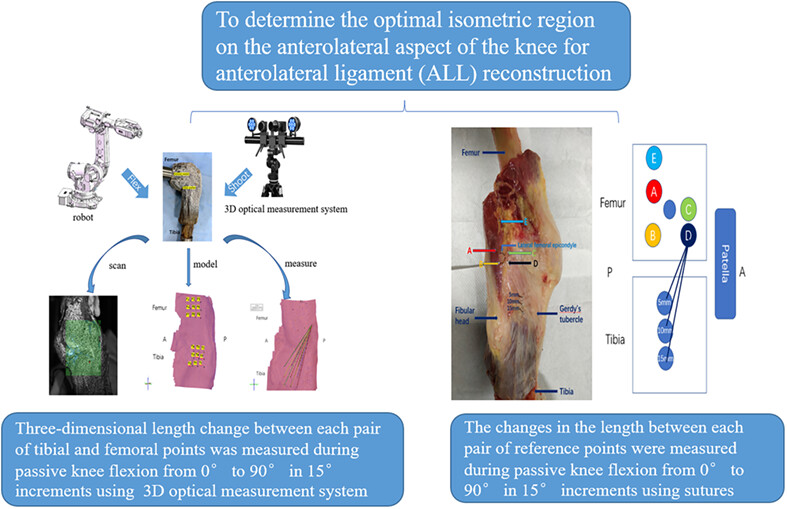
To determine the optimal isometric region on the anterolateral aspect of the knee for anterolateral ligament (ALL) reconstruction by two means: (i) three-dimensional length change between each pair of tibial and femoral points was measured during passive knee flexion from 0° to 90° in 15° increments using 3D optical measurement system; and (ii) the changes in the length between each pair of reference points were measured during passive knee flexion from 0° to 90° in 15° increments using sutures.
TGF-β1 Inhibits Osteoclast Differentiation and Abnormal Angiogenesis in Intervertebral Disc Degeneration: Evidence from RNA Sequencing and Animal Studies
- Pages: 167-182
- First Published: 28 November 2023

Schematic view of the regulatory mechanism of Tgfb1 on bone homeostasis in intervertebral disc degeneration (IDD). In the IDD mice, Tgfb1 can alleviate the occurrence of IDD, and its low expression leads to a disturbance in the balance of bone metabolism. On the one hand, Tgfb1 inhibits the differentiation of osteoclasts, maintains the bone mass of the vertebral body and bony endplate (EP), and protects the mechanical transmission of the intervertebral disc. On the other hand, Tgfb1 inhibits the abnormal formation of bone-related vessels in the cartilage EP, reduces bone formation and ossification of the cartilage EP, and maintains the intervertebral disc matrix metabolism, thus alleviating the occurrence of IDD.
Discovery of Taurocholic Acid Sodium Hydrate as a Novel Repurposing Drug for Intervertebral Disc Degeneration by Targeting MAPK3
- Pages: 183-195
- First Published: 06 November 2023
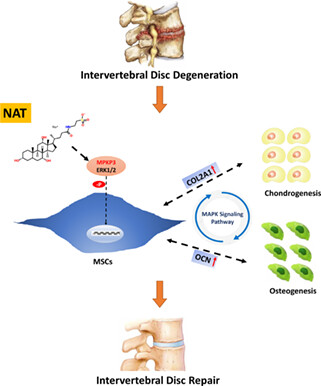
The primary finding of this study was the identification of a novel repurposing drug, taurocholic acid sodium hydrate (NAT), which would induce chondrogenesis and osteogenesis of mesenchymal stem cells (MSCs), ameliorate the secondary osteoporosis and delay the progression of intervertebral disc degeneration (IDD) in mice by targeting MAPK3 (mitogen-activated protein kinase 3). Furthermore, MAPK3, especially the phosphorylation of MAPK3, as a relevant drug target, would be a potential therapeutic agent in in osteogenic differentiation for IDD treatment.
Automatic Detection and Classification of Modic Changes in MRI Images Using Deep Learning: Intelligent Assisted Diagnosis System
- Pages: 196-206
- First Published: 07 November 2023
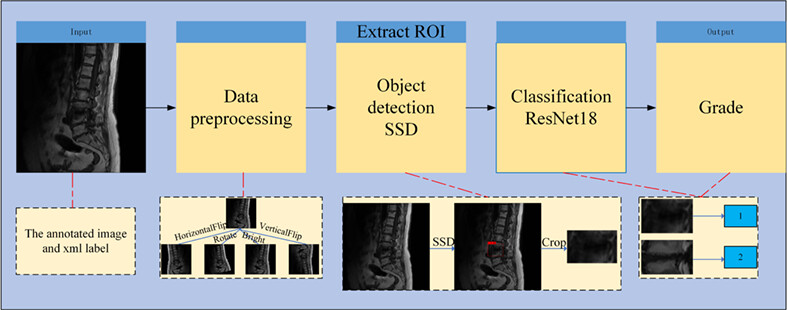
We evaluated the performance of SSD and ResNet18 network-based automatic detection and classification of MCs. Additionally, it compares the inter-observer agreement in MCs diagnosis and the agreement between observers and classifiers to validate the feasibility of deep learning network-assisted detection of classified MCs.
Excess Mortality for Femoral Intertrochanteric Fracture Patients Aged 50 Years and Older Treated Surgically and Conservatively in Tianjin, China: A Cohort Study
- Pages: 207-215
- First Published: 17 November 2023

Elderly patients with femoral intertrochanteric fracture treated with two methods were both found to have an excess mortality rate compared to the general population, although in different levels. The excess mortality rates for patients in the conservative therapy group were 14.46% in males and 17.93% in females, while in the surgical therapy group, it was 2.78% in females and 4.37% in males. After controlling other covariates, surgical therapy could greatly reduce the excess mortality after intertrochanteric fracture.
Race and Gender Differences in Anterior Cruciate Ligament Femoral Footprint Location and Orientation: A 3D-MRI Study
- Pages: 216-226
- First Published: 12 November 2023
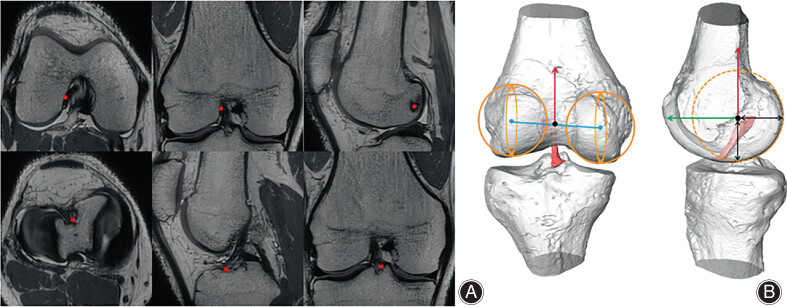
There were significant racial and gender differences in anterior cruciate ligament (ACL) femoral footprint and orientation. It was hoped that the quantitative relationship between the ACL femoral footprint location and orientation could provide some reference for surgeons during anatomic single-bundle ACL reconstruction.
Increased Expression of Inflammatory Cytokines and Discogenic Neck Pain
- Pages: 227-233
- First Published: 14 December 2023
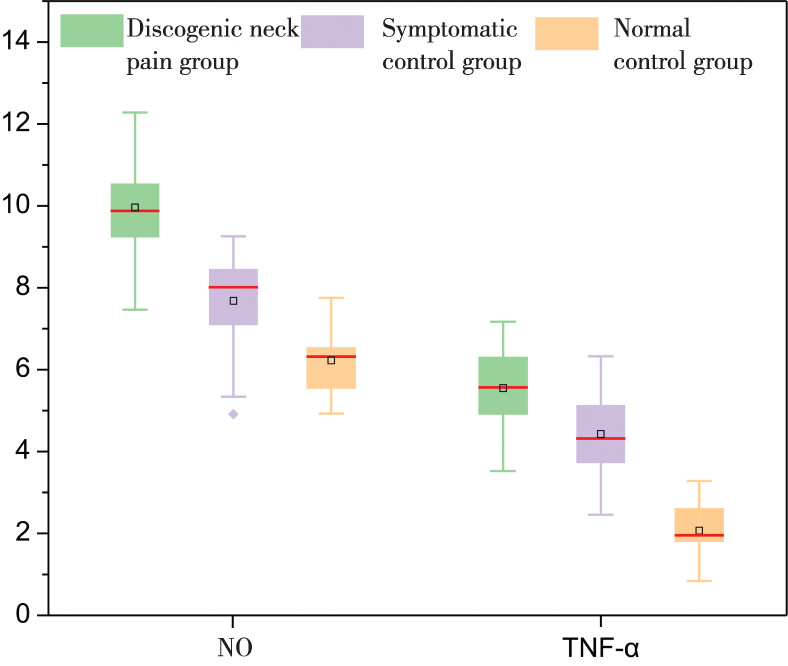
The box plot shows the distribution characteristics of the data of NO and TNF-α in the discogenic neck pain group, the symptomatic control group, and the normal control group. The small square inside the box indicates the mean value. The red line inside the box indicates the median. The colored spot outside the box shows the outliers.
TRADITIONAL CHINESE MEDICINE IN ORTHOPAEDICS
Factors Associated with Re-Displacement after Nonsurgical Treatment of Distal Radius Fractures in Adults: A Retrospective Study
- Pages: 234-244
- First Published: 01 December 2023

Age, AO/OTA typing, and ulnar variation at presentation and immediate reduction are related factors in fracture re-displacement prediction. Age over 65.5 years, ulnar variation >3.26 mm at presentation, and ulnar variation >2.055 mm at immediate reduction were high-risk factors for fracture re-displacement.
OPERATIVE TECHNIQUES
A Femoral Neck Osteotomy for the Patients with Ankylosing Spondylitis and Thoracolumbar Kyphosis Combined with Hip Flexion Contracture
- Pages: 245-253
- First Published: 17 November 2023
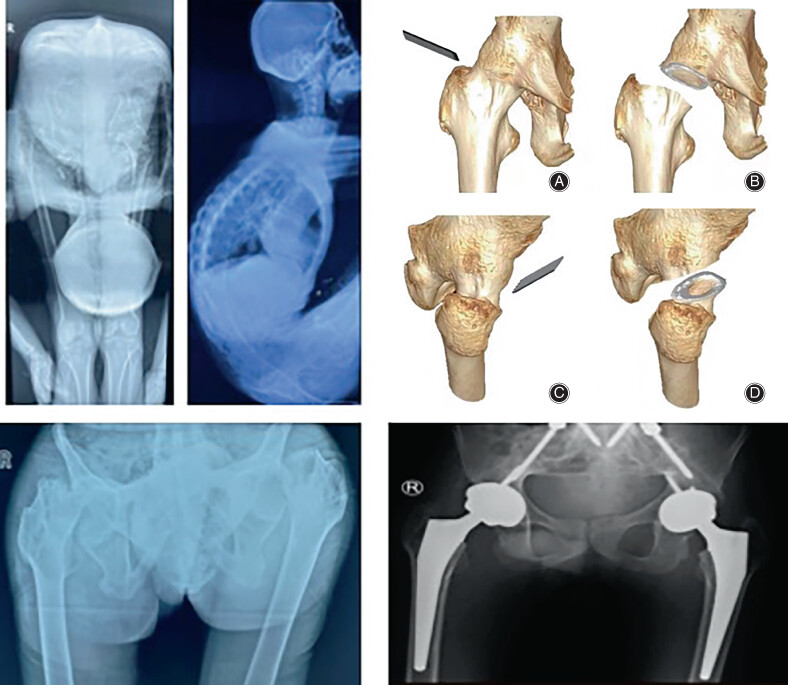
We retrospectively examined a series of our patients with ankylosing spondylitis and severe thoracolumbar kyphosis combined with hip flexion contracture. We designed a new special femoral neck osteotomy method to simplify the pedicle subtraction osteotomy and total hip arthroplasty and decrease the complications.
Arthroscopic Bone Grafting and Robot-assisted Fixation for Scaphoid Nonunion
- Pages: 254-262
- First Published: 14 November 2023

Arthroscopic bone grafting combined with robot-assisted percutaneous Kirschner wires/screw fixation is a feasible and promising therapeutic option for scaphoid nonunions, regardless of the vascularity of the proximal pole fragment. This novel technique allows for anatomic restoration of the scaphoid alignment and accurate, targeted placement of implants into the scaphoid fracture site within a single-attempt using a computerized navigation system.
Minimally Invasive Treatment of Inversion Shortening Calcaneal Fractures in the “Out-In” Position
- Pages: 263-268
- First Published: 10 October 2023
Minimally Invasive Percutaneous Leverage Reduction in the Treatment of Pediatric Salter–Harris IV and V Distal Femoral Physeal Fractures
- Pages: 269-275
- First Published: 19 October 2023
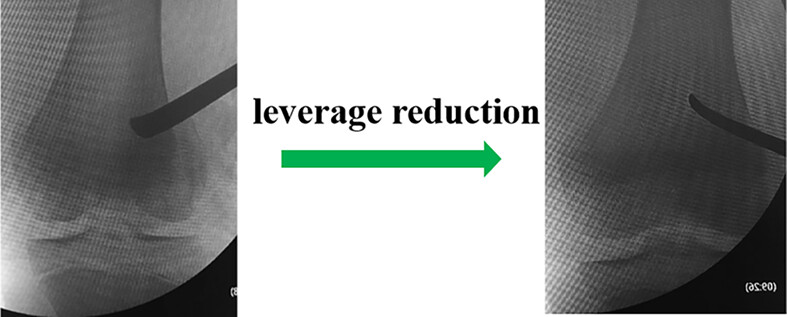
(A–C) Computed tomography (CT) scan images of a 12-year-old girl with a left Salter–Harris (S–H) IV distal femoral epiphyseal fracture; the anteroposterior (AP) intraoperative fluoroscopy show (D) inserting a vessel clamp to locate the junction of the distal femoral fracture block and the metaphysis; (E) inserting a periosteal stripper; (F) using the periosteal stripper to achieve prying reduction; (G–J) the K-wires crosses the fracture line to fixed the fracture with the periosteal stripper to maintain the reduction.
BRIEF REPORT
Liaw's Ellipse Anteversion Method for Distinguishing Acetabular Component Retroversion from Anteversion on Plain Radiographs
- Pages: 276-281
- First Published: 20 November 2023
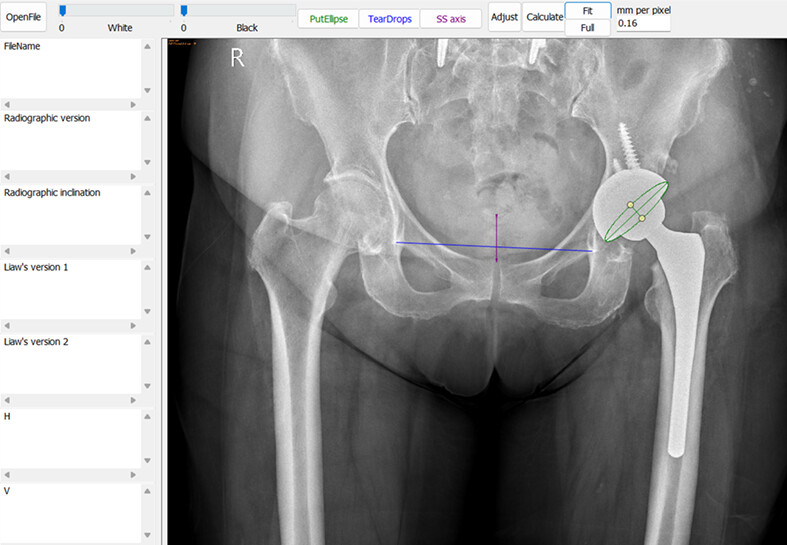
The computerized ellipse method, as far as we know, is the first two-dimensional radiographic method capable of distinguishing retroverted acetabular components in plain radiographs. The Elliversion software facilitates a quick and easy measurement process. Although further cases are necessary to determine the reliability of this method, it can be suggested as a tool for detecting acetabular component retroversion on anteroposterior radiographs during routine postoperative follow-up and retrospective reviews of patients who have undergone THA.
CASE REPORT
Locally Invasive Pigmented Villonodular Synovitis of the Wrist Treated by Arthroscopic Resection and Bone Grafting
- Pages: 282-286
- First Published: 25 October 2023
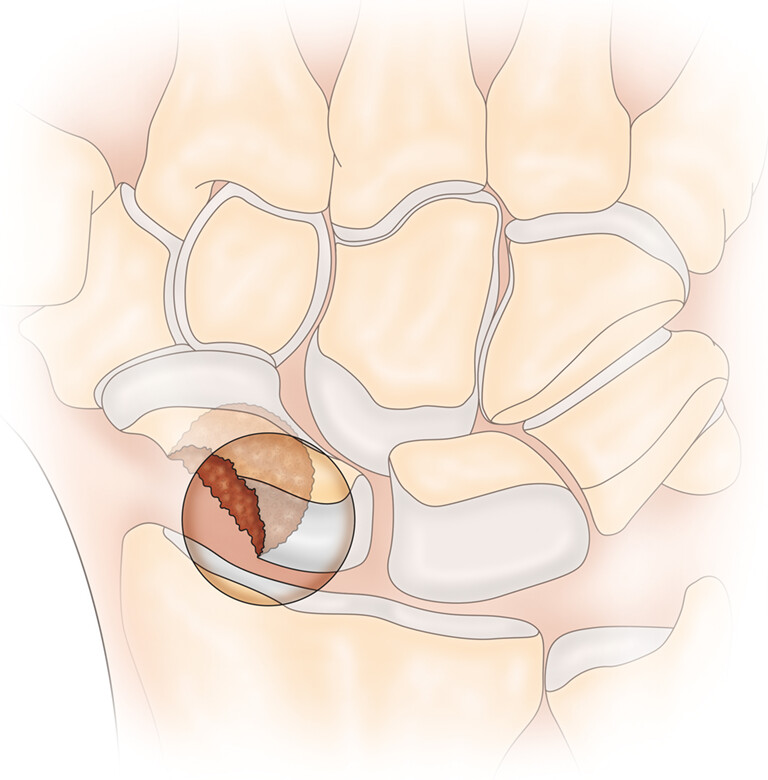
We present an uncommon case of wrist pigmented villonodular synovitis (PVNS) that was painful with aggressive local bony invasion to the scaphoid. The patient underwent a novel surgery using wrist arthroscopic evaluation and resection with bone grafting in one sitting and made an uneventful postoperative recovery.





